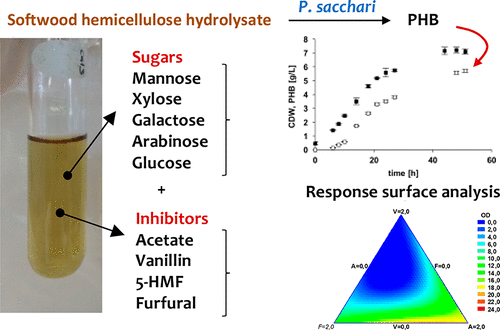当前位置:
X-MOL 学术
›
Biomacromolecules
›
论文详情
Our official English website, www.x-mol.net, welcomes your
feedback! (Note: you will need to create a separate account there.)
Model Study To Assess Softwood Hemicellulose Hydrolysates as the Carbon Source for PHB Production in Paraburkholderia sacchari IPT 101
Biomacromolecules ( IF 5.5 ) Pub Date : 2017-12-08 00:00:00 , DOI: 10.1021/acs.biomac.7b01446 Karolin Dietrich 1 , Marie-Josée Dumont 1 , Timothy Schwinghamer 2 , Valérie Orsat 1 , Luis F. Del Rio 3
Biomacromolecules ( IF 5.5 ) Pub Date : 2017-12-08 00:00:00 , DOI: 10.1021/acs.biomac.7b01446 Karolin Dietrich 1 , Marie-Josée Dumont 1 , Timothy Schwinghamer 2 , Valérie Orsat 1 , Luis F. Del Rio 3
Affiliation

|
Softwood hemicellulose hydrolysates are a cheap source of sugars that can be used as a feedstock to produce polyhydroxybutyrates (PHB), which are biobased and compostable bacterial polyesters. To assess the potential of the hemicellulosic sugars as a carbon source for PHB production, synthetic media containing softwood hemicellulose sugars (glucose, mannose, galactose, xylose, arabinose) and the potentially inhibitory lignocellulose degradation products (acetic acid, 5-hydroxymethylfurfural (HMF), furfural, and vanillin) were fermented with the model strain Paraburkholderia sacchari IPT 101. Relative to pure glucose, individual fermentation for 24 h with 20 g/L mannose or galactose exhibited maximum specific growth rates of 97% and 60%, respectively. On the other hand, with sugar mixtures of glucose, mannose, galactose, xylose, and arabinose, the strain converted all sugars simultaneously to reach a maximum PHB concentration of 5.72 g/L and 80.5% PHB after 51 h. The addition of the inhibitor mixture at the following concentration, sodium acetate (2.11 g/L), HMF (0.67 g/L), furfural (0.66 g/L), and vanillin (0.93 g/L), to the sugar mixture stopped the growth entirely within 24 h. Individually, the inhibitors either had no effect or only reduced growth. Moreover, it was found that a bacterial inoculum with high initial cell density (optical density, OD ≥ 5.6) could overcome the growth inhibition to yield an OD of 13 within 24 h. Therefore, softwood hemicellulose sugars are viable carbon sources for PHB production. Nevertheless, real softwood hemicellulose hydrolysates need detoxification or a high inoculum to overcome inhibitory effects and allow bacterial growth.
中文翻译:

评估软木半纤维素水解物作为糖原副代虫的IPB 101生产PHB的碳源的模型研究
软木半纤维素水解物是糖的廉价来源,可以用作生产聚羟基丁酸酯(PHB)的原料,该聚羟基丁酸酯是生物基且可堆肥的细菌聚酯。为了评估半纤维素糖作为生产PHB的碳源的潜力,使用含有软木半纤维素糖(葡萄糖,甘露糖,半乳糖,木糖,阿拉伯糖)和潜在抑制性木质纤维素降解产物(乙酸,5-羟甲基糠醛(HMF))的合成培养基,糠醛和香兰素)均通过模型菌株Paraburkholderia sacchari进行发酵IPT101。相对于纯葡萄糖,分别用20 g / L甘露糖或半乳糖发酵24 h的最大比生长率分别为97%和60%。另一方面,使用葡萄糖,甘露糖,半乳糖,木糖和阿拉伯糖的糖混合物,该菌株同时转化所有糖,在51小时后达到5.72 g / L的最大PHB浓度和80.5%的PHB。向糖混合物中停止添加以下浓度的抑制剂混合物:乙酸钠(2.11 g / L),HMF(0.67 g / L),糠醛(0.66 g / L)和香兰素(0.93 g / L)完全在24小时内增长。单独地,抑制剂要么没有作用,要么只有减少的生长。此外,发现细菌接种物具有高的初始细胞密度(光学密度,OD≥5)。6)可以克服生长抑制,在24小时内产生13的OD。因此,软木半纤维素糖是生产PHB的可行碳源。然而,真正的软木半纤维素水解物需要排毒或高接种量才能克服抑制作用并允许细菌生长。
更新日期:2017-12-08
中文翻译:

评估软木半纤维素水解物作为糖原副代虫的IPB 101生产PHB的碳源的模型研究
软木半纤维素水解物是糖的廉价来源,可以用作生产聚羟基丁酸酯(PHB)的原料,该聚羟基丁酸酯是生物基且可堆肥的细菌聚酯。为了评估半纤维素糖作为生产PHB的碳源的潜力,使用含有软木半纤维素糖(葡萄糖,甘露糖,半乳糖,木糖,阿拉伯糖)和潜在抑制性木质纤维素降解产物(乙酸,5-羟甲基糠醛(HMF))的合成培养基,糠醛和香兰素)均通过模型菌株Paraburkholderia sacchari进行发酵IPT101。相对于纯葡萄糖,分别用20 g / L甘露糖或半乳糖发酵24 h的最大比生长率分别为97%和60%。另一方面,使用葡萄糖,甘露糖,半乳糖,木糖和阿拉伯糖的糖混合物,该菌株同时转化所有糖,在51小时后达到5.72 g / L的最大PHB浓度和80.5%的PHB。向糖混合物中停止添加以下浓度的抑制剂混合物:乙酸钠(2.11 g / L),HMF(0.67 g / L),糠醛(0.66 g / L)和香兰素(0.93 g / L)完全在24小时内增长。单独地,抑制剂要么没有作用,要么只有减少的生长。此外,发现细菌接种物具有高的初始细胞密度(光学密度,OD≥5)。6)可以克服生长抑制,在24小时内产生13的OD。因此,软木半纤维素糖是生产PHB的可行碳源。然而,真正的软木半纤维素水解物需要排毒或高接种量才能克服抑制作用并允许细菌生长。











































 京公网安备 11010802027423号
京公网安备 11010802027423号